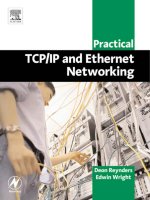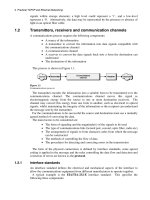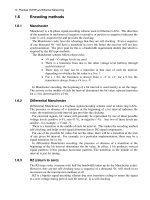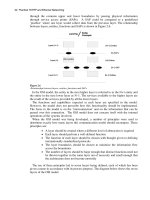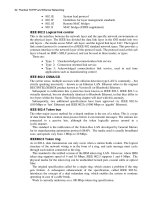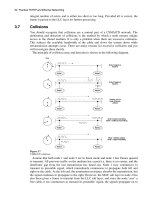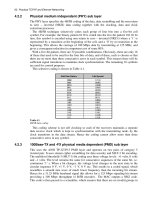Practical TCP/IP and Ethernet Networking- P38 ppsx
Bạn đang xem bản rút gọn của tài liệu. Xem và tải ngay bản đầy đủ của tài liệu tại đây (581.35 KB, 5 trang )
:)6/6[ZOROZOKY
4+:9:':
This is used for obtaining protocol statistics and current active connections utilizing
TCP/IP. Nowadays there are many Windows-based utilities that can do much more; yet in
an emergency netstat is certainly better than nothing at all. Here follows the netstat
options.
C:\WINDOWS.000>netstat /?
Displays protocol statistics and current TCP/IP network connections.
NETSTAT [-a] [-e] [-n] [-s] [-p proto] [-r] [interval]
-a Displays all connections and listening ports.
-e Displays Ethernet statistics. This may be combined with the
-s option.
-n Displays addresses and port numbers in numerical form.
-p proto Shows connections for the protocol specified by proto; proto
may be TCP or UDP. If used with the -s option to display
per-protocol statistics, proto may be TCP, UDP, or IP.
-r Displays the routing table.
-s Displays per-protocol statistics. By default, statistics are
shown for TCP, UDP and IP; the -p option may be used to
specify a subset of the default.
interval Re-displays selected statistics, pausing interval seconds
between each display.
Press CTRL+C to stop re-displaying statistics. If omitted,
netstat will print the current configuration information once.
C:\WINDOWS.000>
In response to the netstat -e command the following packet and protocol statistics are
displayed. This is a summary of events on the network since the last re-boot.
C:\WINDOWS.000>netstat -e
Interface Statistics
Received Sent
Bytes 2442301 1000682
Unicast packets 4769 3776
Non-unicast packets 113 4566
Discards 0 0
Errors 0 0
Unknown protocols 19
C:\WINDOWS.000>
4(:9:':
This provides protocol statistics and current TCP/IP connections using NBT (NetBIOS
over TCP/IP). This is relevant with Windows 95/98 etc, which uses NetBIOS for the
upper layers of the OSI model.
C:\WINDOWS.000>nbtstat /?
Displays protocol statistics and current TCP/IP connections using NBT (NetBIOS over
TCP/IP).
NBTSTAT [-a RemoteName] [-A IP address] [-c] [-n] [-r]
[-R] [-s] [S] [interval] ]
-a (adapter status) Lists the remote machine’s name table given
its name
6XGIZOIGR:)6/6GTJ+ZNKXTKZ4KZ]UXQOTM
-A (Adapter status) Lists the remote machine’s name table given
its IP address.
-c (cache) Lists the remote name cache including the IP
addresses
-n (names) Lists local NetBIOS names.
-r (resolved) Lists names resolved by broadcast and via WINS
-R (Reload) Purges and reloads the remote cache name table
-S (Sessions) Lists sessions table with the destination IP
addresses
-s (sessions) Lists sessions table converting destination IP
addresses to host names via the hosts file.
RemoteName Remote host machine name.
IP address Dotted decimal representation of the IP address.
Interval Re-displays selected statistics, pausing interval seconds
between each display. Press Ctrl+C to stop re-displaying
statistics.
C:\WINDOWS.000>
/6)54,/-
This shows the entire TCP/IP configuration present in a host. It also has the additional
versatility of interfacing with a DHCP server to renew a leased IP address.
Ipconfig will return, amongst other things, the host’s IP address, its subnet mask and
default gateway.
C:\WINDOWS.000>ipconfig /?
Windows 98 IP Configuration
Command line options:
/All - Display detailed information.
/Batch [file] - Write to file or ./WINIPCFG.OUT
/renew_all - Renew all adapters.
/release_all - Release all adapters.
/renew N - Renew adapter N.
/release N - Release adapter N.
C:\WINDOWS.000>
An options often used is ‘ipconfig /all’. In the case of a multi-homed host, i.e. one with
more than one network interface card (including dial-up modem) ‘ipconfig /all’ will
display the details of each card.
Note that ipconfig will list the generic name of the adapter. Therefore, a 3010 3Com US
Robotics 56K modem is simply listed as a PPP adapter, while a Linksys Ethernet
10BaseT/10Base2 Combo PCMCIA card is listed as a generic Novell 2000 adapter,
which it emulates.
C:\WINDOWS.000>ipconfig /all
Windows 98 IP Configuration
Host Name . . . . . . . . . : COMPUTER100
DNS Servers . . . . . . . . :
Node Type . . . . . . . . . : Broadcast
NetBIOS Scope ID. . . . . . :
IP Routing Enabled. . . . . : No
WINS Proxy Enabled. . . . . : No
NetBIOS Resolution Uses DNS : No
:)6/6[ZOROZOKY
0 Ethernet adapter :
Description . . . . . . . . : PPP Adapter.
Physical Address. . . . . . : 44-45-53-54-00-00
DHCP Enabled. . . . . . . . : Yes
IP Address. . . . . . . . . : 0.0.0.0
Subnet Mask . . . . . . . . : 0.0.0.0
Default Gateway . . . . . . :
DHCP Server . . . . . . . . : 255.255.255.255
Primary WINS Server . . . . :
Secondary WINS Server . . . :
Lease Obtained. . . . . . . :
Lease Expires . . . . . . . :
1 Ethernet adapter :
Description . . . . . . . . : Novell 2000 Adapter.
Physical Address. . . . . . : 00-E0-98-71-57-AF
DHCP Enabled. . . . . . . . : No
IP Address. . . . . . . . . : 207.194.66.100
Subnet Mask . . . . . . . . : 255.255.255.224
Default Gateway . . . . . . :
Primary WINS Server . . . . :
Secondary WINS Server . . . :
Lease Obtained. . . . . . . :
Lease Expires . . . . . . . :
C:\WINDOWS.000>
=/4/6),-
Winipcfg (Windows IP Configuration) provides the same information as ‘ipconfig /all’,
but in a Windows format. Like ipconfig, it is capable to force a DHCP server into
releasing and reissuing leased IP addresses.
Figure 9.2
Windows IP configuration
It can be invoked from the DOS prompt, or from the Windows ‘run’ command. Click
the more details tab for an expanded view.
6XGIZOIGR:)6/6GTJ+ZNKXTKZ4KZ]UXQOTM
Figure 9.3
Winipcfg display (courtesy of Microsoft Corporation)
:8')+8U[:K
This is often used to trace failures along a TCP/IP communications path. The spelling of
the command varies slightly. For UNIX it is traceroute, for Windows it is tracert.
The following figure shows the tracert options.
C:\WINDOWS.000>tracert
Usage: tracert [-d] [-h maximum_hops] [-j host-list] [-w timeout] target_name
Options:
-d Do not resolve addresses to hostnames.
-h maximum_hops Maximum number of hops to search for target.
-j host-list Loose source route along host-list.
-w timeout Wait timeout milliseconds for each reply.
C:\WINDOWS.000>
Here follows a route trace from Perth, Australia, to a server in the USA.
C:\WINDOWS.000>tracert www.idc-online.com
Tracing route to www.idc-online.com [216.55.154.228] over a maximum of 30 hops:
1 169ms 160ms 174ms slip202-135-15-3-0.sy.au.ibm.net [202.135.15.30]
2 213ms 297ms 296ms 152.158.248.250
3 624ms 589ms 533ms sfra1sr1-2-0-0-5.ca.us.prserv.net [165.87.225.46]
4 545ms 535ms 628ms sfra1sr2-101-0.ca.us.prserv.net [165.87.33.185]
5 564ms 562ms 573ms 165.87.160.193
6 558ms 564ms 573ms 114.ATM3-0.XR1.SFO1.ALTER.NET
[146.188.148.210]
7 574ms 701ms 555ms 187.at-2-10.TR1.SAC1.ALTER.NET
[152.63.50.230]
8 491ms 480ms 500ms 127.at-6-10.TR1.LAX9.ALTER.NET
[152.63.5.101]
9 504ms 534ms 511ms 297.ATM7-0.XR1.LAX2.ALTER.NET
[152.63.112.149]
10 500ms 478ms 491ms 195.ATM9-0-0.GW2.SDG1.ALTER.NET
[146.188.249.81]
11 491ms 564ms 584ms anet-gw.customer.ALTER.NET [157.130.224.154]
12 575ms 554ms 613ms www.idc-online.com [216.55.154.228]
Trace complete.
C:\WINDOWS.000>
:)6/6[ZOROZOKY
As is often the case, the DOS approach is not the user-friendliest option. Notice the
result when the same trace is done with TJPingPro. The same TCP/IP protocols viz. ARP
and ICMP are still used, but now they are accessed through a third-party application
program (TJPingPro) which accesses the TCP/IP stack through a
WinSock interface.
Figure 9.4
TJPingPro trace (courtesy of Top Jimmy Software)
The most comprehensive tracing is, however, done via application programs such as
Neotrace. The following figures give some of the results of a trace to the same location
used for the previous two examples.
Figure 9.5
NeoTrace display (courtesy NeoWorx Inc)
